What is Spinal Cord Injury?
The spinal cord is a bundle of nerves that carries messages between the brain and the rest of the body and it is part of your child’s nervous system. It sends information from the brain to the body, and carries sensory information from the skin, bones, muscles, and organs back to the brain. If your child receives an injury to the spinal cord, then the nerves stop working. Then our child’s body can be affected in ways you can see, such as an inability to move his legs. Among these are the ability to control the bladder and the flow of urine. When the nerves control messages to start and stop the flow of urine and do not work properly, it is called neurogenic bladder. Acute spinal cord injury is when the spinal cord is damaged by an accident and a spinal cord injury may be a bruise, or a partial tear, or a complete tear in the spinal cord. Spinal cord injury is a common cause of long-lasting disability and death in children.
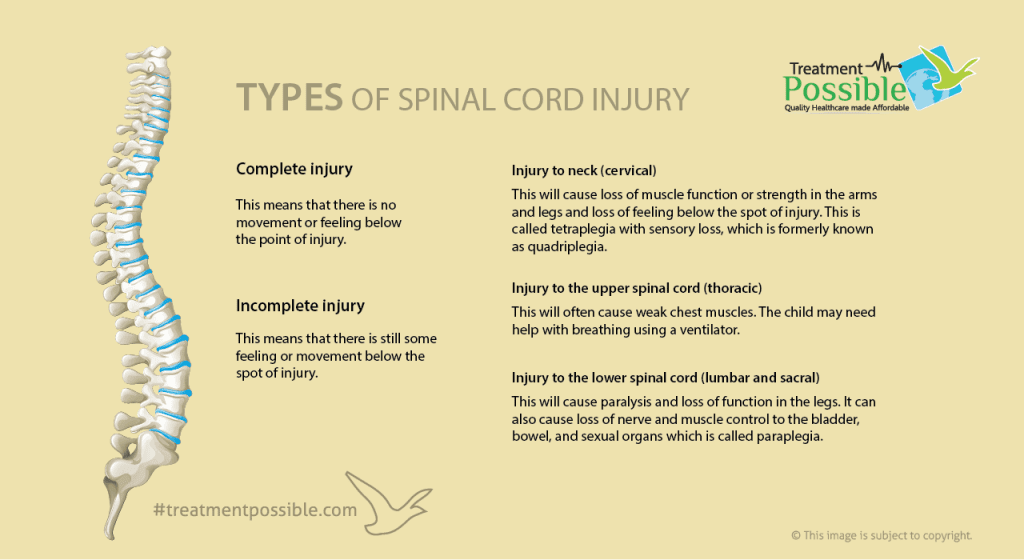
What Causes Spinal Cord Injury?
There are many causes of spinal cord injury in children. The most common injuries occur when the area of the spine or neck is bent or compressed. This can happen from:
- Delivery during birth often affects the spinal cord of the child in the neck
- Falls
- A motor vehicle accident
- Sports injury
- Diving accident
- Infection which forms an abscess on the spinal cord
- Injury which blocks circulation to the spinal cord
Want more clarification about medical expense & treatment plan?
Plan for spine surgery In India
Get a Free Doctor's OpinionWhatapp UsWhat are the Symptoms of Spinal Cord Injury?
Symptoms may depend on the spot where the spinal cord is injured. Symptoms can be different in each child. The spinal cord injury causes a loss or decrease in sensation, muscle movement, and reflexes. As swelling goes away, the symptoms may occur. The common symptoms of spinal cord injury
may include:
- Muscle weakness
- Loss of muscle movement in the chest, arms, or legs
- Breathing problems
- Loss of sensation in the chest, arms, legs, or buttocks
- Loss of bowel and bladder function
- Poor blood pressure control, sweating, shivering, and abnormal function of the stomach and intestines (abnormal autonomic regulation)
- Neurologic symptoms and signs may be delayed from 30 minutes to 4 days after injury in about 25% of affected children.
When spinal cord injury occurs in major trauma, such as from a car accident or fall from height. The symptoms of a spinal cord injury in trauma may include the following:
- Trouble walking or breathing
- Lumps on the spine or on your child’s head
- Symptoms of a neurogenic bladder from spinal cord injury may include Retaining urine, frequent urinary tract infections, Incontinence, or leaking of urine.
However, the Spinal cord injury is divided into 2 types which are based on the spot of the injury:
- Complete injury: This means that there is no movement or feeling below the point of injury.
- Incomplete injury: This means that there is still some feeling or movement below the spot of injury.
The Symptoms depend on where the spinal cord is injured. For example:
- Injury to neck (cervical) – This will cause loss of muscle function or strength in the arms and legs and loss of feeling below the spot of injury. This is called tetraplegia with sensory loss, which is formerly known as quadriplegia.
- Injury to the upper spinal cord (thoracic) – This will often cause weak chest muscles. The child may need help with breathing using a ventilator.
- Injury to the lower spinal cord (lumbar and sacral) – This will cause paralysis and loss of function in the legs. It can also cause loss of nerve and muscle control to the bladder, bowel, and sexual organs which is called paraplegia.
Request a Free Estimate

- Travel to India for Affordable and Advanced Healthcare
How is Spinal Cord Injury Diagnosed in a Child?
A spinal cord injury may be diagnosed as part of an overall health assessment following trauma by a spine specialist. In such case, your child may need the following tests:
- Computed tomography (CT):This test uses X-rays and a computer to make detailed images of the body. A CT scan will show detailed images of any part of the body, including the bones, muscles, fat, and organs. CT scans are more detailed than standard X-rays.
- Magnetic resonance imaging (MRI):This imaging test uses large magnets to make detailed images of organs and tissues in the body. MRI provides better images of the spinal cord than CT scans.
- X-ray: This test uses electromagnetic energy beams to make images of internal tissues, bones, and organs to the film.
- Neurological Exam: Doctors will perform complete neurological examinations a few days after an injury occurs so that they can assess how the injury affects the child’s ability to use muscles and feel sensations. They combine information from the neurological examination with information from the images to assign a classification of the injury based on a standard scale. Neurophysiological tests will check as to how well the nerve signal pathways work through the spinal cord.
- Urological testing: Urine samples and a test called urodynamic study is used to diagnose a neurogenic bladder. During the study, your child’s bladder is filled with saline, or a salt solution, to allow doctors to measure the volume, tone and pressure of the bladder also how well it contracts.
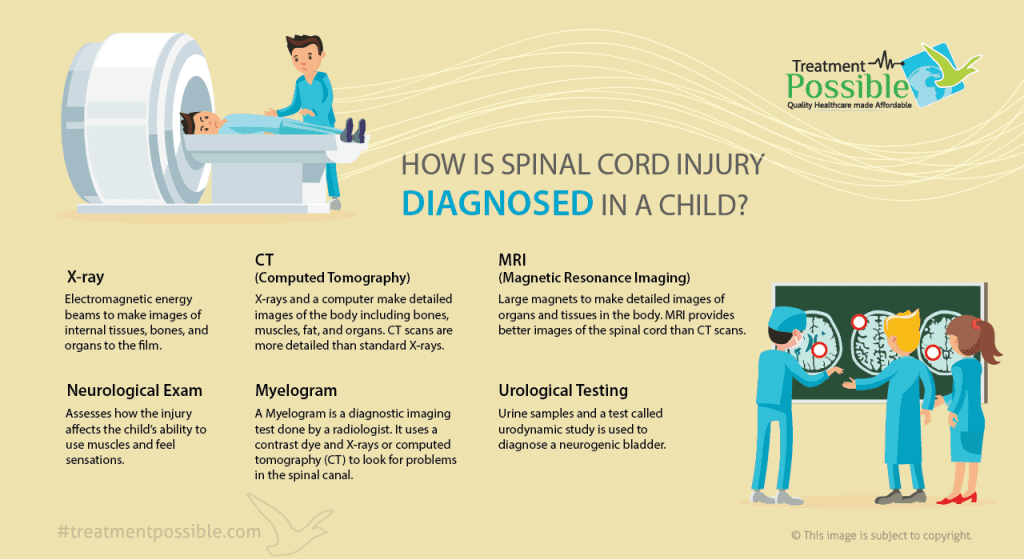
How is Spinal Cord Injury?
Treatment depends on your child’s symptoms, age, and general health. It also depends on how severity of the condition. Spinal cord injury may first be treated at the scene of the accident. This is done by preventing the head and neck from moving. Treatment may also include:
- Close watch in the intensive care unit
- Medicines will be given to reduce the swelling in the spinal cord
- Help with breathing from a mechanical ventilator or respirator
- A tube placed in the bladder (bladder catheter) to drain urine into a bag
- Feeding tube placed into the stomach through a nostril or through a cut in the belly
- Surgery to treat broken backbones, release the pressure from the injured area.
Recovery from spinal injury in children will require a long-term stay in the hospital and rehabilitation (rehab). A team of healthcare providers, nurses, and other specialists have to watch and manage your child’s health. This includes managing:
- Pain
- Heart function
- Blood pressure
- Body temperature
- Nutritional status
- Bladder and bowel function
- Uncontrolled muscle shaking (spasticity)
During rehab, physical, occupational, or speech therapists will work with your child. Rehab focuses on preventing muscles from becoming weak or stiffening. Therapists have to work to retrain your child to use other muscles for tasks and mobility.
You should talk with your child’s healthcare providers about the risks, benefits, and possible side effects of the treatments.
What are Possible Complications of Spinal Cord Injury?
The complications may include the following:
- Pressure sores – These are called bedsores. They are wounds caused by ongoing pressure on the same area of the skin. The healthcare team will instruct you to move your child’s body every few hours.
- Lung infection (pneumonia) – This is treated with antibiotics.
How can I Prevent Spinal Cord Injuries?
Some risk-reducing measures include the following:
- always wearing a seatbelt while in a car
- wearing proper protective gear while playing sports
- never diving into water unless you have examined it first and made sure that it is deep enough and free of rocks
Pediatric Spine Surgery at Treatment Possible:
Treatment Possible is associated with the Best Pediatric Spine Surgeons who are specialized in spinal cord surgery. We work with the Best hospital for spine surgery in India that is equipped with OT and are compatible for complex spine surgeries. Treatment Possible associates with pediatric spine surgeon who are experienced in operating complex Spine Surgeries on a Child as well as on an adult.
Treatment Possible ensures high-quality spinal cord surgery while guaranteeing the lowest medical services and surgery cost. Our understanding of the Indian Medical Services, Healthcare market and our valued relations with the pediatric spine specialist enable us to provide spinal surgery at a price that is reasonable, affordable and transparent.
Get Free Consultation with the Top 10 Spine Surgeon in India with the hassle-free setup of post-operative recovery care, medical travel & stay during the medical treatment. You can also send your medical reports for spinal cord surgery to care@treatmentpossible.com for free opinions and suggestions from the best pediatric spinal surgeon. No matter what the health condition, you always get good healthcare options and cost advantage from Treatment Possible!
Our Services
From Treatment To Recovery, We Are Always There With You!
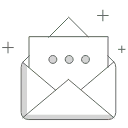
Medical Visa Letter
We provide a Medical visa letter for which we require the scanned passport copies of the patient and attendant.
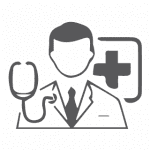
Arrange An Appointment With A Surgeon
We arrange for the appointment with the surgeon, confirm for the hospital room and operation theatre (if required)
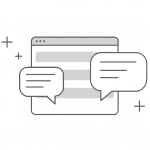
Post Surgery Follow Up
We help you to fix your telephonic appointment for future follow-ups
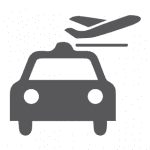
Complimentary Pickup
We arrange for complimentary pickup and drop services from the airport.
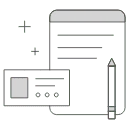
All The Necessary Arrangements
We arrange for hospital admission, forex exchange, sim card and local assistance

No Need To Worry About Essential Expenses!
We help in sorting out the hospital bill, return ticket, medicines and other essential purchases.
